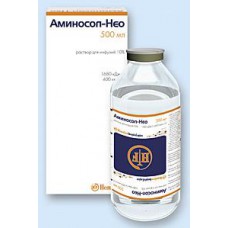Expiration date: 08/2026
The composition and form of issue:
Solution for infusion 10% 1000 ml contains:
L-isoleucine 5 g
L-leucine of 7.4 g
L-valine 6.2 g
L-lysine 6.6 g
(corresponds to L-lysine to monoacetate) of 9.31 g
L-methionine 4.3 g
L-threonine 4.4 g
L-phenylalanine 5.1 g
L-alanine 14 g
L-arginine 12 g
glycine 11 g
L-histidine 3 g
L-Proline 11.2 g
L-serine 6.5 g
L-tyrosine 0.4 g
taurine 1 g
L-tryptophan 2 g
auxiliary substances: glacial acetic acid — q.s. water for injection to 1000 ml
the energy value is 1680 kJ/l (400 kcal/l) theoretical osmolality — 990 mOsm/l pH — 5.5 to 6.5
in bottles of 500 ml cartons 1 a bottle.
Solution for infusions 15% 1000 ml contains:
L-isoleucine 5.2 g
L-leucine 8.9 g
L-valine 5.5 g
L-lysine is 11.1 g
(corresponds to L-lysine to monoacetate) of 15.66 g
L-methionine 3.8 g
L-threonine 8.6 g
L-phenylalanine 5.5 g
L-alanine 25 g
L-arginine 20 g
glycine 18.5 g
L-histidine is 7.3 g
L-Proline, 17 g
L-serine and 9.6 g
L-tyrosine 0,4
taurine 2 g
L-tryptophan 1.6 g
auxiliary substances: glacial acetic acid and 4.2 g of acid L-malic — q.s. water for injection to 1000 ml
the energy value is 2520 kJ/l (600 kcal/l) theoretical osmolality — 1505 mOsm/l pH — 5.5 to 6.5
in bottles of 500 ml cartons 1 a bottle.
Pharmacokinetics:
Parenterally administered amino acids are used in the body in protein synthesis.
Not used in this process dezaminiruet amino acids to form urea which is then excreted in the urine. T1/2 amino acids in healthy humans is 5-15 min. some of the amino acids may not undergo biotransformation (excreted unchanged) the expected effect of the drug in this case disappears. This pharmacokinetic feature can be eliminated by introducing the drug slowly, so that the concentration of amino acids in the blood are not sharply increased. This method of administration allows to avoid allocation of amino acids through the kidneys in an unmodified form.
Description pharmacological action:
Aminosol-Neo — combined drug for parenteral nutrition that contains essential (eight), conditionally essential and non-essential amino acids in optimal proportions. All amino acids are in L form that provides for their direct involvement in the biosynthesis of proteins.
The nitrogen content to 10% solution of 16.2 g/l, for a 15% solution of 25.7 g/l.
Amino acids only in 10% solution — 100 g/1000 ml, 15% solution — 150g/1000ml.
The energy value for 10% solution — 400 kcal, for 15% solution — 600 calories.
Indications:
- parenteral feeding the partial or total (with the addition of fat emulsions, electrolytes and carbohydrates)
- prevention and compensation of loss of protein and fluid, in case of impossibility of enteral nutrition: severe cases of gastrointestinal diseases (obstruction, malabsorption, inflammatory bowel disease, pancreatitis, intestinal fistulas), hypermetabolic States (trauma, burns, sepsis) and other cases requiring parenteral nutrition (in malignant diseases, in preparation for surgery and after surgery).
Contraindications:
- metabolic acidosis
- severe renal and hepatic failure
- shock
- hypoxia
- decompensated heart failure
- pregnancy
- lactation
- children up to age 18 years (effectiveness and safety have not been established).
Application of pregnancy and breast-feeding:
Application during pregnancy and lactation — efficacy and safety have not been established.
Side effects:
When applying Aminosol-Neo 10 or 15% solutions possible deficiency of folate in the body, resulting in therapy with this drug the necessary daily intake of folic acid.
Drug interactions:
Not recommended uncontrolled addition of other drugs to the solution Aminosol-Neo.
Farmatsevticeski compatible with such antibiotics as amikacin, ampicillin, Cefotaxime, Ceftriaxone, doxycycline, erythromycin, gentamicin, chloramphenicol, clindamycin, netilmicin, penicillin, piperacillin, tetracycline, tobramycin and vancomycin with other drugs, such as theophylline, cyclophosphamide, cimetidine, cytarabine, digoxin, dopamine, famotidine, fitomenadion, fluorouracil, folic acid, furosemide, heparin, chlorpromazine, insulin, calcium gluconate, lidocaine, methyldopa, methylprednisolone, metoclopramide, methotrexate, morphine, nizatidin, norepinephrine, propranolol, ranitidine, and Riboflavin.
Co-administration of arginine with thiazide diuretics and aminophylline increases the amount of insulin in the blood.
Estrogens and oral contraceptives can increase the increasing the concentration of growth hormone, caused by arginine, and lower glukagonovy and insulin response to arginine.
The interaction of arginine with spironolactone can cause severe hyperkalemia.
Arginine is not compatible with sodium thiopental.
Method of application and dose:
(By infusion into a Central vein).
The dosage is individual, according to the severity of metabolic disorder and the body's need for amino acids.
10% solution
Average dose for adults is 10-20 ml/kg/day, respectively, 1-2 g amino acids/kg/day. The maximum infusion rate of 1 ml/kg/h recommended infusion rate is 20 to 35 drops/min, maximum daily dose of 20 ml/kg.
15% solution
The average adult dose is 6.7 to 13.3 ml/kg/day, respectively, 1-2 g amino acids/kg/day. The maximum allowable rate of introduction — 0.67 ml/kg/h, maximum daily dose is 13.3 ml/kg.
For a person weighing 70 kg the daily dose is 470-930 ml, and the recommended rate of administration — 16 drops/min.
Dosing in renal insufficiency: patients who are not on dialysis, and recommend the introduction of proteins in the dose of 0.6–1 g/kg/day in the dialysis is 1.2–2.7 g/kg/day.
Dosage in hepatic insufficiency: patients with hepatic insufficiency do not tolerate high amounts of amino acids and therefore, their need for the proteins is 0.8–1.1 g/kg/day.
Overdose:
Symptoms: nausea, vomiting, sweating, fever, tachycardia. With a high speed of injection may be hypervolemia and electrolyte composition of plasma. These phenomena are reversible.
Treatment: symptomatic. It is necessary to reduce the infusion rate or stop administration of the drug.
Special instructions:
The arginine that is part of the drug can lead to a decrease of the phosphorus concentration and increasing the concentration of potassium in plasma. These changes are particularly pronounced in patients with diabetes.
Insulin inhibits the hyperkalemia induced by arginine, therefore, patients under stress and in patients with diabetes mellitus (both type 1 and type 2), you need to inject insulin if they get Aminosol-Neo.
Apply only the clear solution from the intact bottle!


